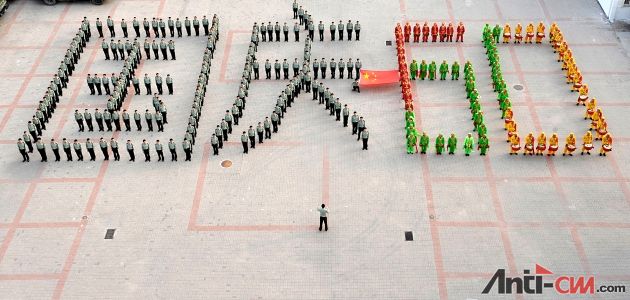【中文标题】打开黑箱 - 中国那些让人摸不着头脑的统计数据揭示了很多问题
【原文标题】Unpacking the Black Box - China’s dicey statistics tell us a lot
【登载媒体】新闻周刊
【原文作者】John Lee
【原文链接】http://www.newsweek.com/2010/07/30/unpacking-the-black-box.html

中国天津,一所陆军军官学校的学生们。
邓小平对中国共产党再三强调的一句格言是“实事求是”,最近发布的中国第二季度GDP增长数字为10.3%,这似乎告诉我们,这个中土帝国是很难做到这一点的。令人惊奇的是,这个数字显示了“政策左右”的经济放缓,中国老练的分析人士已经开始在事后评论这个数字。但是,这个数字令人不快的出台过程不仅可以让我们了解准确的数字是什么,还能告诉我们中国真正做的如何。
首先一点,怎么有那么多质疑的声音?国家统计局每个季度都例行公事一般做同样的动作。统计数据来自全国各地,各省以惊人的速度汇总数据——大约两个星期,相当于很多使用效率更高的数据收集方式的发达国家的三倍。
国家统计局将这些数据分类,“请示”共产党高官,使用神秘的方法将其修整成型,最终丢出来的数据与北京政治巨头当初设定的目标完美吻合。在若干年之后,人们获取到各省详尽的历史数据,经过中国经济学家的分析,官方的数据被再次修改。其中发现的巨大差异遭受各方谴责,结果往往是北京承诺仔细调查统计数据收集过程中存在的“结构性缺陷”。
当然,历史数据有时也会证明官方的数据与目标值接近,每季度的统计过程让我们详细认识到现代中国的运作方式和中国“市场社会主义”的核心缺陷。唐朝时期(公元618 – 907),每2927人中有一个是官员;更近一些的清朝(1644 – 1911),每299人中有一个是官员。但是在当代中国,总共有5000万名官员,大约27人中就有一人当官。这种官僚作风当然无法抱怨人手不足了。
而且,当代中国是亚洲过分统治现象最严重的国家,也是管理最差劲的国家之一。即使中国已经将部分权力下放,并成倍地增加官员数量,但是这个国家依然没有形成增加透明度和负责任的机制。中国共产党在法庭、官僚机构、媒体、研究机构和国有企业方面的影响人所共知。当北京需要依赖这些共产党地方官员在山高皇帝远的地方维护党的权力的时候,这些人很难真正负起责任来。
还有另外一个问题,国家是中国经济体中一个举足轻重的参与者,国有企业掌握了国家总资产的四分之三以上,国家拥有全国固定资产总量的65%以上。这意味着,那些有权决定四分之三国家投资走向的地方官员,对国有企业的经营运作有绝对的影响力。他们控制资产、土地、甚至劳动力的分配。在中国广大的政治和官僚网络中爬上象征身份、权力和财富的阶梯,需要的是政绩,而政绩通常取决于官员的镇子、城市、省份中占主导地位的国有经济体是否达到了中央设定的目标。
这又把我们带回了官方数据的话题,这些数据都是来自于地方官员的报告。这些官员有巨大的动力去告诉北京它愿意听到的任何有关达成中央目标的事情——至于这些目标是呈危险趋势的增长,还是刻意放缓都是无所谓的事情。这是他们职业晋升的基础。说谎的正面效果是显著的,而负面效果却几乎没有,他们似乎不可能因为伪造数据被捉到,更不用说受到惩罚了。
糟糕的统计数据本身还并不是最严重的问题。在中国国家掌控全局的趋势下,没有有效管理这样一个幅员辽阔的国家的能力,才是真正迫在眉睫的问题。西方通常把“市场社会主义”视为一个冷酷、高效的体系,因为它使用从上到下的政策贯彻模式,却忽视了一个现实——恰当地验证官方数据是几乎不可能的。实事求是,这句话既睿智又务实,是改革中国的一条中肯建议。但仅仅是事实,就已经很难得到了。
原文:
Students at a military academy in Tianjin, China
Deng Xiaoping’s oft-repeated aphorism for the Chinese Communist Party is to “seek truth from facts.” As the recently released second-quarter GDP growth figure of 10.3 percent reminds us, this is difficult to do when it comes to the Middle Kingdom. Amazingly, the figure represents a “policy-engineered” slowdown; seasoned China analysts are already second-guessing it. But the fraught process of how these figures are arrived at should tell us as much about how China is really faring as the accurate growth number itself.
First things first: why is there so much skepticism? Every quarter, the National Bureau of Statistics goes through the same ritual. Statistics come in from all over the country. The provinces compile them with impossible speed—around two weeks, or three times as fast as many developed economies with much more efficient processes of data collection.
The NBS sorts through them, “consults” with senior CCP officials, applies a mysterious methodology to trim them into shape, and then spits out a figure that is uncannily well aligned with the targets set by political masters in Beijing. After several years, provincial historical data is tediously retrieved and analyzed by Chinese economists, and official figures are revised. Significant discrepancies are discovered and condemned, ending with Beijing promising to meticulously address the “structural flaws” in the statistical gathering process.
While historical data shows that official figures can sometimes be close to the mark, the quarterly statistical ritual offers insight into how modern China is actually run and into a fundamental weakness of Chinese “market socialism.” During the Tang Dynasty (A.D. 618–907), there was one official for every 2,927 people. During the more recent Qin Dynasty (1644–1911), there was one official for every 299 people. But in modern China, there are up to 50 million officials, amounting to about one official for every 27 people. Its bureaucracy certainly cannot complain about being understaffed.
Yet, while modern China is the most overgoverned land in Asia, it is also one of the worst governed. Even as China has decentralized and officials have multiplied, the country is not building the institutions needed for better transparency and accountability. CCP’s influence over courts, bureaucracies, media, research institutions, and state-controlled enterprises are well known. It’s difficult to make CCP’s local officials accountable when Beijing relies on them to maintain the party’s hold on power in far-flung places.
There is also another problem. The state remains a significant player in the Chinese economy. State businesses receive more than three quarters of the country’s capital. The state owns more than 65 percent of the country’s fixed assets. This means local officials—who make more than three quarters of all state investment decisions—have an overwhelming influence on running these state businesses. They control the dispensation of capital, land, and sometimes even labor. Climbing the greasy ladder of status, power, and wealth within China’s vast political and bureaucratic network depends on results. And results are usually defined by whether the dominant state-controlled sectors in one’s township, city, or county are meeting centrally mandated targets.
This brings us back to the official numbers, which are derived from reporting by local officials. These officials have massive incentives to tell Beijing what it wants to hear as regards hitting central targets—whether it be breakneck growth or an engineered slowdown. It is the basis for their promotion. While the upside for dishonesty is obvious, there is usually little downside, as it’s unlikely they will be caught, let alone punished, for fudging figures.
Dodgy statistics is not in itself the most serious problem. In China’s state-dominated approach, the incapacity to effectively govern such a vast country is the real and pressing issue. The common Western view of “market socialism” as a ruthlessly efficient system, when it comes to top-down policy implementation, ignores the reality that proper verification of any official number is almost impossible. Seeking truth from facts is a wise and pragmatic piece of advice for reforming China. But getting the facts first could be the hard part.
|